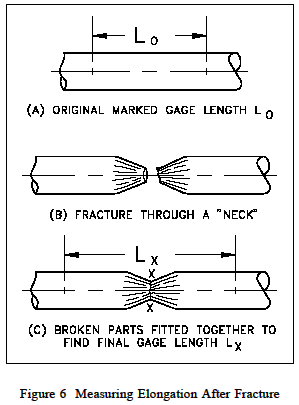Ductility - Strength ( Mechanics ) of Materials
Strength / Mechanics of Materials Table of Content
Ductility is the percent elongation reported in a tensile test is defined as the maximum elongation of the gage length divided by the original gage length. The measurement is determined as shown in Figure 6.

Measuring Elongation After Fracture
where
Pe = Percent elongation
Lx = initial length
Lo = final length
Reduction of area is the proportional reduction of the cross-sectional area of a tensile test piece at the plane of fracture measured after fracture.
where
Ra = Precent reduction of area
Ai = Cross ectional area initial
Af = Cross ectional area
The reduction of area is reported as additional information (to the percent elongation) on the deformational characteristics of the material. The two are used as indicators of ductility, the ability of a material to be elongated in tension. Because the elongation is not uniform over the entire gage length and is greatest at the center of the neck, the percent elongation is not an absolute measure of ductility. (Because of this, the gage length must always be stated when the percent elongation is reported.) The reduction of area, being measured at the minimum diameter of the neck, is a better indicator of ductility.
Ductility is more commonly defined as the ability of a material to deform easily upon the application of a tensile force, or as the ability of a material to withstand plastic deformation without rupture. Ductility may also be thought of in terms of bendability and crushability. Ductile materials show large deformation before fracture. The lack of ductility is often termed brittleness. Usually, if two materials have the same strength and hardness, the one that has the higher ductility is more desirable. The ductility of many metals can change if conditions are altered. An increase in temperature will increase ductility. A decrease in temperature will cause a decrease in ductility and a change from ductile to brittle behavior.
Cold-working also tends to make metals less ductile. Cold-working is performed in a temperature region and over a time interval to obtain plastic deformation, but not relieving the strain hardening. Minor additions of impurities to metals, either deliberate or unintentional, can have a marked effect on the change from ductile to brittle behavior. The heating of a cold-worked metal to or above the temperature at which metal atoms return to their equilibrium positions will increase the ductility of that metal.
Related
- Modulus of Resilience Equation and Calculator
- Mohr's Circle for Plane Stress
- Mohr's Circle Simplified Video
- Mohr's Circle when normal stress in the X direction is negative
- Shear Stress
- Shear Stress in Shafts Equations
- Shear Center for Beams Equations and Calculator
- Strain
- Bolt Preload Tension Force Calculator
- Fastener / Thread Tensile Area of External Thread Formula
- Fastener / Threaded Pitch Circle Diameter Formula and Calculation
- Fastener / Threaded Shear Area Formula and Calculation